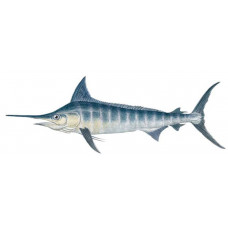Latin name
Tetrapturus audax
Other names
Striper, marlin, Pacific marlin, Pacific striped marlin, barred marlin, spikefish, spearfish, New Zealand marlin, red marlin (Japan); Arabic: kheil al bahar; French: empéreur; Hawaiian: a’u, nairagi; Japanese: makajiki; Portuguese: espadim raiado; Spanish: agujón, marlín, marlin rayado, pez aguja.
Identification
The body of the striped marlin is elongated and compressed, and its upper jaw is elongated in the shape of a spear. The coloration is dark or steel-blue from above and turns bluish-silvery and white under the clearly visible and straight lateral line. Numerous iridescent blue spots adorn the fins, and pale blue or lavender vertical stripes appear on the sides. They may or may not be visible. The stripes persist after death, which is not always characteristic of other marlins. The most characteristic feature is a tall, pointed first dorsal fin, which is usually equal to or greater than the greatest depth of the body. Even in the largest specimens, this fin is at least 90 percent of the body depth. The anal and pectoral fins, like the dorsal fin, are pointed. They are also flat and mobile and easily fold flush to the sides even after death. The striped marlin has scales, fins on its belly, and a rounded spear.
Distribution
In the eastern Pacific, striped marlin are found as far away as Oregon, but are the most common south of Point Conception, California. It usually appears off the California coast in July and lasts until late October. The best place to fish in California is in a belt of waters that extends from the eastern tip of Santa Catalina Island to San Clemente Island and south toward the Los Coronado's Islands. The waters around the Baja Peninsula, Mexico, are especially known for striped marlin, which are especially abundant off Cabo San Lucas.
Habitat
Striped marlin inhabits tropical and warm temperate waters of the Indian and Pacific Oceans and is a pelagic and seasonally migratory species, moving toward the equator during the cold season and away from it during the warm season. Striped marlin inhabit the warm blue water of the shelf surroundings, usually above the thermocline.
Size
The largest striped marlin in history is a 494-pound fish caught in New Zealand in 1986. In the United States, the largest fish is a California fish, weighing 339 pounds. They are found from 100 pounds to 200 pounds.
Life history and Behavior
The life history of this species is little known. They are mostly solitary, but may form schools of size during the spawning season. They are usually present where there is plenty of food.
Food and feeding habits
The striped marlin is a predator and feeds on sawfish, anchovies, mackerel, saury, flying fish, squid, and anything else that comes in abundance. The marlin's spear is sometimes used for protection and as an auxiliary tool for food extraction. Marlins have often rammed wooden boats, and on one occasion the spear penetrated 181⁄2 inches of hardwood, 141⁄2 inches of which was oak. When a striped marlin uses its spear to grab food, it stuns its prey by side-striking the spear rather than thrusting it into the prey, as some believe.
Reproduction
No information
| Classification | |
| Phylum | Chordata |
| Class | Actinopterygii |
| Squad | Istiophoriformes |
| Family | Istiophoridae |
| Genus | Tetrapturus |
| Species | T. audax |
| Features | |
| Conservation status | Least Concern |
| Habitat | Pelagic |
| Life span, years | No information |
| Maximum body weight, kg | 440 |
| Maximum length, cm | 420 |
| Sailing speed, m/s | No information |
| Threat to people | Edible |
| Way of eating | Predator |




